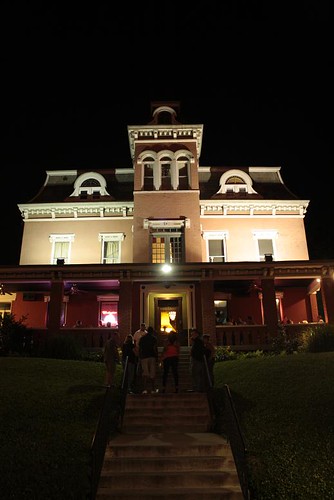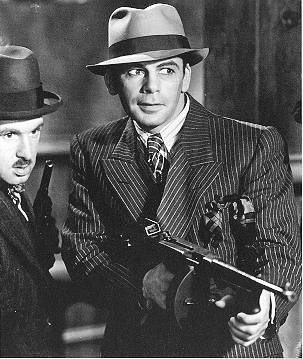
"Tommygun" Inventor
Marker Number 1706:
Brig. Gen. John T. Thompson, USA, inventor of Thompson submachine gun, was born here in 1860. A West Point graduate of 1882, he was early advocate of automatic weapons and improved many small arms. Awarded Distinguished Service Medal as Director of Arsenals in World War I. General Thompson died in 1940, lamenting the notoriety of the Tommygun as a gangster weapon.I picked this marker to talk about because recently, we lost the concert venue that this marker sat in front of: The Southgate House. I was going to share my many pictures I have taken of The Southgate House but apparently, they only exist in my mind. I am not sure how I visited a place so often and yet, have not one single decent picture of it on my flickr.

Photo by Jasmine Cupp and not myself.
The Southgate House was my favorite concert venue. It was one of the few places that, when I found a favorite band was playing there, I did not follow with "ugh." I am not even for sure why I liked it so much. It was smokey and often overly packed. However, it was in Kentucky, despite a band's listing on their website as playing in Cincinnati, so bonus points right there.
But enough about the Southgate House as a concert venue and let's go back to the Southgate House as the birthplace of John Taliaferro Thompson.
 |
He was born on Dec. 31 1860 to Lt. Col. James Thompson and Julia Maria Taliaferro.
Taliaferro inherited the house from her mother who inherited it from her father, Richard Southgate. Richard Southgate in his lifetime was everything from a lawyer to a State Representative to a Senator. Also, he is where Southgate, KY got its name.
John T. Thompson's Father, Col. James Thompson, fought for the Union in the Civil War at Glendale and Chickamauga. Chickamauga was a terrible defeat and Glendale is viewed sort of as a tie. I would like to think that his father's involvement in two less than stellar battles for the Union somehow influenced young John into inventing a weapon that would give his team (whatever that may be) a better advantage.
The point is, John T. Thompson came from a fairly well-off and well-known family. With his father being in the military, John grew up on several army posts. He eventually graduated from the United States Military Academy in 1882.
 |
His first post after graduating was back in familiar territory in Kentucky, serving at the Newport Barracks (July 16, 1882 - Jan. 4, 1884).
 |
Thompson was sent to Tampa, FL and promoted to Lieutenant Colonel at the start of the Spanish American War. It was during this war that he saw the necessity to create a weapon that would fire at a faster rate, creating a superior firearm.
He was made chief of the Small Arms Division for the Ordnance Department after the war. There, he helped oversee the development of a new type of pistol and rifle.
 |
The M1903 Springfield being the rifle.
Before America got involved in World War I, Thompson was already part of the fight. Having retired from the Army, he took a position as Chief Engineer of The Remington Arms Company. He recognized the need for small arms in the upcoming war and also the potential to make a bit of a profit.
A couple years after the beginning of the war, he began experimenting in earnest on automatic small arms. With financial support from the Auto-Ordnance Company, he began work that would eventually become his most well-known creation, the Thompson submachine gun AKA the "Tommy Gun."
In 1917, when the US joined World War I, he came out of retirement and rejoined the Army and was promoted to the rank of brigadier general. After the war, he again retired and finally perfected his invention.
Unfortunately, though fortunately for us, when he finished his Thompson submachine gun, there was not much of a market because World War I was not over. Yes, it was a high speed, lightweight weapon that was much better than the popular Gatling guns, but when there where no trenches to sweep it, was a hard sale.
He did sell quite a few to law enforcement but sales were only modest. Eventually the Auto-Ordnance Company had to replace him as their head.
 |
 |
Today, the Thompson submachine gun is not in popular real world use but his invention helped pave the way for many rapidly firing weapons. However, in pop culture, John T. Thompson and his "Tommy Gun" live on.
 |

I love this post! And your inventor/model comment made me laugh out loud!
ReplyDeleteI must admit, I never actually read the sign out front - going in the building, I was always so excited and coming out, I couldn't always see straight...
Anyway, I learn quite a lot from the information you add to these markers. I look forward to the next one.
Thanks Callie!
DeleteYes, I know personally of your love of the booze. When you are drunk the places you occupy become sanctuaries and you are the priest on the offensive trying to milk out every last confession, hehe.
I second Callie's comment. I'm enjoying these tidbits of Kentucky history, although the idea of a man who could contemplate a trench mower and, worse, actualize it is rather disturbing.
ReplyDeleteHaha, yeah. The Southgate House is right along the Ohio river facing Cincinnati, so I hope that was not part of the inspiration. That place looks like it is getting crowded, I wonder if there is something that can be done about it....
DeleteAn interesting note regarding the Thompson. It is an American Classic firearm, and most should understand that it's ridiculously long. To be more precise, the stock or what's known in gun talk as "length of pull" is ridiculously long. This is because John T. Thompson was 6'6" tall which one can observe from the perspective in that one photo where he's holding his progeny (sans stock as the 1921/1928 models had a pushbutton quick detach buttstock) like a pistol, which, even with the stock removed weighed over 10 lbs! A big man.
ReplyDeleteAs a firearms manufacturer for over 14 years, it always gnawed at me that even in the later incarnations of the classic Tommy, the M1 and M1A1 models, made specifically for military use (simplified machining operations, no blish lock, no top charging handle, no oiler, smooth barrels) and typically without the Cutt's Compensator, forward pistol grip and lacking the ability to accept the iconic drum magazine that the stock issue was never addressed.
To shoot a Thompson it feels like you have to push the thing out into the next county to shoulder it.
The Thompson is still made by Auto-Ordnance in semi-auto long barreled versions and short barreled versions (which require registration with the Feds and a $200 dollar transfer tax upon change of ownership) and are somewhat popular still.
Auto-Ordnance is owned by Kahr Arms which also owns Magnum Research (The Desert Eagle people), all owned by relatives of the Moonies.
Really.
A great post and good research. I admire your Kentucky pride and admit I just kinda fell in here doing some research on John T.
Thanks for sharing all of your insight! We bloggers are way more likely to know about the history of any given firearm than how it is to operate, so it's very cool to hear your thoughts.
DeleteThanks for your nice and well thought out comment. These are so rare it is like an internet miracle, heh. Again thanks and I enjoyed your additional details.
Delete